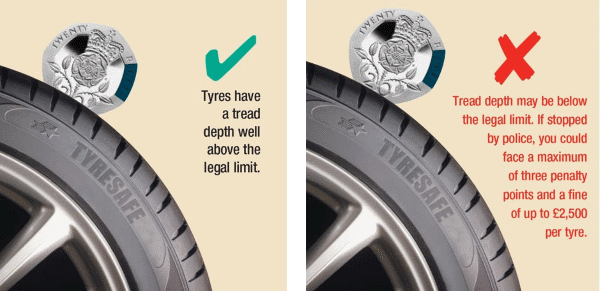How to check tyre tread depth & what to look out for.
Article written by Bush Tyres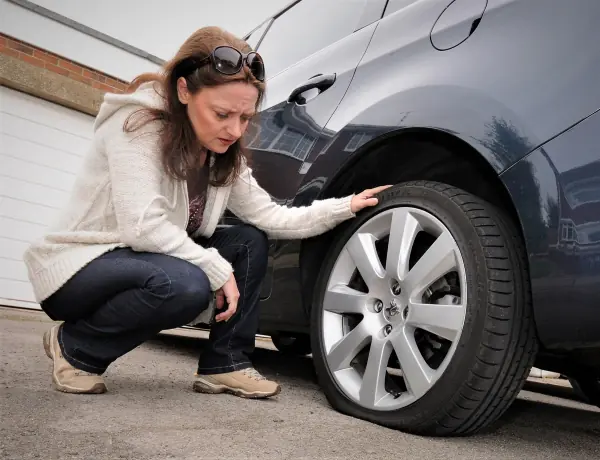
We all know that our car will fail an MOT if there is notenough tread on our tyres.
With this check in place some drivers pay little orno attention to their tyres until the MOT or, sadly, when their tyres fail onthe road. Some of you may think there is little you can do if a tyre ‘blowsout’, many will say it is just bad luck however, the real reason in almost allcases is that the owner/driver has paid little attention to the one thing (allfour) that gives them the contact with the road, maintains traction and dispelswater from under the tyre to prevent aquaplaning. Aquaplaning is a phenomenonwhere the tyre fails to displace the water and builds up under the tyreeffectively raising the tyre off the road surface so you will not be able tosteer, brake or accelerate effectively.
Tread is often misunderstood as the thing that gives yougrip on the road, if we look at Formula 1 tyres they have no tread pattern atall and achieve maximum grip, not forgetting the aerodynamic enhancements too,they have all the available rubber on the road, that is until it rains – pit stop!The wet tyres (with tread pattern) are fitted and off they go racing again.
Obviously we cannot pit stop on the public road, so our roadtyres are optimised to work in the dry, and the wet, and the very reason wehave tread. A normal road tyre will displace, on average, around 10 litres ofwater per second (varies on tyre size, width) Formula 1 wet tyres displacearound 60 litres per second. For normal road use that 10 litres is more than enoughin most circumstances and some drivers will have experienced a small aquaplanegoing through a puddle or standing water with even new tyres. Tread is vital todisplacing water and as the tyre wears that displacement becomes less efficient, add to thatincorrect tyre pressure and the tyre will be operating outside of the designparameters and will displace less water as the ‘footprint’ on the road is notchanges. As your tyres wear so your braking distance increases exponentially.Typically, at 50mph you will stop an extra 33 metres further on with tyres with1.6mm of tread compared with tyres that have 3mm of tread.
Tyresnormally have around 8mm of tread when new but vary slightly betweenmanufacturers.The legal minimum tread depth for cars is 1.6mm across the centralthree-quarters of the width of the tyre, and across the entire circumference.Once your tread gets as low as this, you need to replace the tyre although manymotoring organisations would recommend the tyre be changed at 2mm because of thereduction in efficiency as it wears and gets closer to the legal limit. Policevehicles in Lincolnshire have a limit of 3mm.
So what is the easiest way to check the tread depth? There are tyretread depth gauges available but by far the easiest method I have found isusing a 20p coin.
Place the 20p coin in the main groove of the tyre and if the part of thecoin with ‘TWENTY PENCE’ written on it disappears, then your tyres have enoughdepth. You should carry out the check in 3 or 4 different places around thetyre just in case it has worn unevenly, not forgetting the inner part of thetread that maybe out of reach. Move the car forward, safely, to check thebottom of the tyre.
That said, tyres have Tyre Wear Indicators (TWI), these are small raised blocks(2mm) in the bottom of the tread that enable you to see, when the remaining is tread is level with the outsidediameter, it is time to change the tyre. However, when they are levelyour tyres could be at the legal limit or lower and not the recommended minimum tread depth. . If you areunsure contact a specialist
Checking the tread depth is one issue, while you are there check fordamage, cracks or lumps in the side wall and items stuck in the tread, becareful though, if your tyre is badly worn it may have exposed the steel wiresthat are in the casing, be careful, these are thin enough (like needles) to cut your bare hands. If yousee, or feel, wires protruding from the tyre it must be changed. If you findanything embedded in the tyre change it for the spare, if you have one, thenask a specialist if it can be repaired. Some punctures can be repaired, butonly by a specialist.
When in doubt seek expert advice.
Winter tyres, if you have them fitted, need more tread depth for them tooperate correctly and should be replaced with 4mm of tread left. This is becuase winter tyres are designed to hold snow in the tread so when the tyre comes into contact with the snow on the ground a superior grip is achieved. It sounds like a hard concept to grasp, but the next time it snows, grab two snowballs & try twisting them together & you will find they just lock to each other. Typically, with winter tyres, you can stop around 11metres sooner even at just 20mph than on a normal tyre so it is essential theyhave a minimum of 4mm tread depth to operate correctly.
So, what if you get it wrong and yourtyres are worn past the legal limit?
Besides the legal penalties where you could receive 3penalty points on your licence for each tyre and a possible £2500 fine, in the worstcase you also put yourself in danger of having your car unfit for the roadwhich then puts other road users at risk. If you have a collision and someoneis seriously injured, or even killed because you failed to maintain your tyres,the Collision Investigation Team, who investigate all serious and fatalincidents on our roads, will present a prosecution file to CrownProsecution Service and, if you are found guilty, you could be sent to prison.
3points for each tyre and upto a £2500 fine
At the start of thisarticle I mentioned the contact a tyre has with the road, your tyres play suchan important role in your safety but we (some drivers) happily bounce up anddown kerbs, drive through potholes or just do not look at any debris, or whatis on the road surface, that may damage tyres. Look after your tyres and theyshould look after you. If you need help, or are unsure, seek specialist help –Make sure your tread depth is at a safe depth.
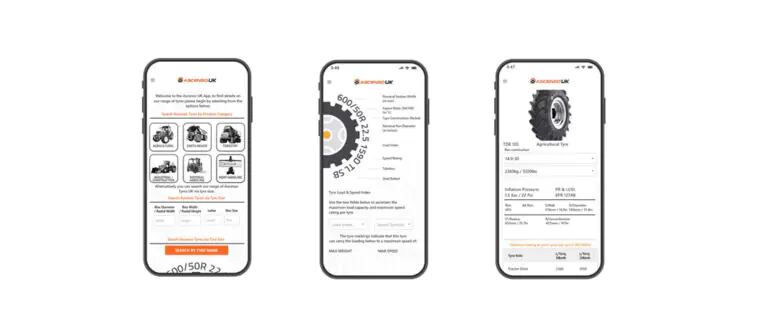
At this years LAMMA to be held at the Birmingham NEC, Ascenso Tyres UK will be launching a new a brand new App especially designed to provide in depth knowledge on tyre pressures, load ratings and best uses for their Ascenso Tyres





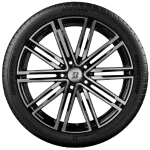 Tyres
Tyres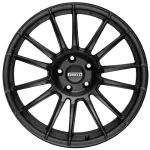 Services
Services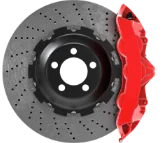 Fast Fit
Fast Fit Offers
Offers